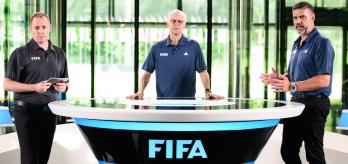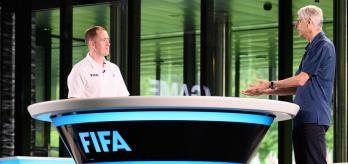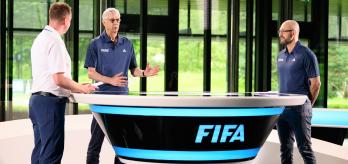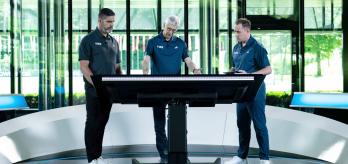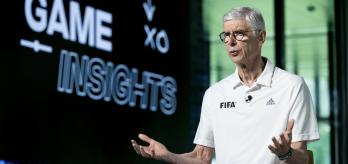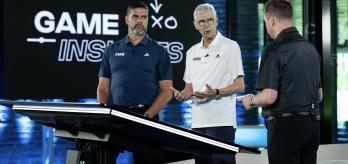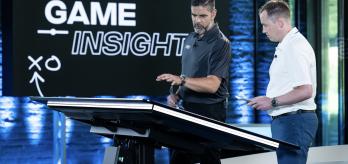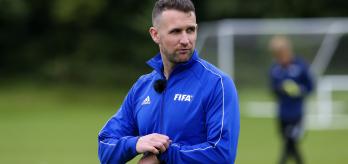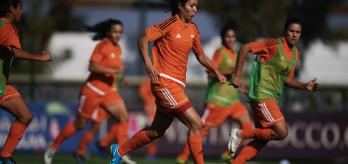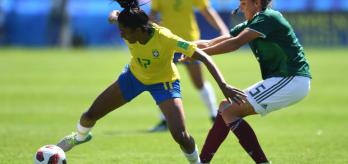Chris Loxston (Group Leader, Football Performance Analysis & Insights), Arsène Wenger (Chief of Global Football Development), and Pascal Zuberbühler (FIFA Goalkeeping Specialist) explain how this rule change has affected the game, which strategies have evolved as a result, and what impact this will have on player training in the future. Zuberbühler also introduces the FIFA Goalkeeping Expert Group's "distribution framework", which breaks down the various forms of distributing first balls into five overarching categories. Using this framework as a lens, the panellists then analyse a selection of examples from recent FIFA tournaments that further demonstrate the rule change’s impact on how the game is played.
Part 1: Introduction - the rule change and its impact
02:58
Initial underestimation
The impact of the rule change was underestimated by many. It was introduced to make the game faster and more spectacular, but even more has changed. As teams are now able to receive a goal kick in their own penalty area, the space available for build-up play has increased by 640m², which has allowed teams to build up with more time.
04:04
Resulting trends
Due to the high press, the goalkeeper is now the extra player and is involved in the build-up play from the back. The significant changes brought about by the rule change have made it necessary to train for these situations.
05:16
Goalkeeper passing length (FIFA U-20 World Cup Poland 2019™)
The Italy goalkeeper tended to play short passes, while for the eventual tournament winners, Ukraine, the goalkeeper primarily resorted to long balls. For the Japan goalkeeper, on the other hand, short, medium and long passes tended to balance one another out. The types of goal kicks used by a team can reflect their overall style of play.
06:28
Saudi Arabia v. France (FIFA U-20 World Cup Poland 2019)
Usually the goalkeeper plays the ball out to one side and then, more often than not, receives the ball back because the pressing team also shifts to the side of the first pass and closes it down, making it impossible for the team to play through. Realising this, the team in possession will tend to pass back to the goalkeeper, who then switches the play to the other side, which is now open. The clip demonstrates this passage of play well.
08:26
Switching play to the opposite side
In modern football, with high pressing a norm, it is vital to be able to switch the play to the opposite side. This means that midfielders now need to be able to control the ball with a good first touch, turn quickly, and continue the play forwards.
09:22
The use of short passes
The key to success is using a mixture of long and short passes. If a team relies only on short passes, they become too predictable, making it difficult for them to hurt their opponents. Nevertheless, short passes in build-up play can lure the opponents away from their goal. If a team manages to get past the opposition's press, they can find the space needed to get in front of goal.
Part 2: Playing out from the back – positional analysis
00:18
Goalkeeper requirements
Essentially, for goalkeepers, it all comes down to decision-making. They must be able to read the game and choose the right pass in any given situation. In addition, it is better if they can play with both feet so that they can distribute the ball to both sides of the pitch, even when under pressure.
00:55
Centre-back requirements
In the modern game, central defenders have to be complete players. In addition to good decision-making, they need to have a variety of skills: a good first touch with both feet, awareness of their team-mates and opponents, the ability to play precise long balls, and the ability to break free from the opponents' press by bursting into midfield.
02:39
Full-back requirements
Full-backs usually play high and wide. This helps the team to stretch the opponents and to make the pitch as wide as possible. As they are often the recipients of long balls, full-backs definitely need a good first touch.
03:25
Centre-midfielder requirements
To minimise the risk of losing the ball, which can result from a high press in the centre, centre-midfielders must constantly scan the pitch and be able to turn on both sides to move the play forward. In addition, they need to have the technical ability to switch the play with precise long balls.
04:40
Attacking line requirements
To be difficult to predict, a team must be able to play both short and long. Playing long passes requires one player up front who can hold the ball up, accompanied by another who can make well-coordinated runs in behind.
Part 3: Distribution framework
00:08
The FIFA Goalkeeping Expert Group has developed a framework that demonstrates the ways in which a goalkeeper can play out from the back. It is a useful tool for identifying trends in how goal kicks are integrated into the team's wider build-up play. The framework breaks down the different forms of distribution into five general categories:
- Play around and support (for example to a centre-back)
- Play through (for example to a central midfielder)
- Play into (for example to a full-back in a relatively high position)
- Play onto (for example to a centre forward)
- Play beyond (behind the opponents’ defence)
02:28
Evolution of the goal kick
"In the past, the idea was to play the long ball as high as possible to make it difficult for the opponent when making a defensive header. In modern football, on the other hand, these goal kicks should be played as high as necessary and as flat as possible so that the ball reaches its destination as quickly as possible." (AW)
Part 4: Examples
00:18
Liverpool v. Flamengo (FIFA Club World Cup Qatar 2019™)
Liverpool's goalkeeper plays the ball to the left centre-back, who passes it back to him. The goalkeeper then plays a precise long ball to the midfielder on the left side of the pitch, who is able to turn and link up with his team-mates up towards the opposition goal. Here, it is clear that the goalkeeper distributes the ball by playing through the opposition’s press.
01:25
A consequence of the rule change
Due to the rule change, the players in the team taking the goal kick now need to focus on taking up their positions first. As a result, the original goal of speeding up the game has not entirely been achieved yet.
02:27
Italy v. Mexico (FIFA U-20 World Cup Poland 2019)
Italy's central defender receives the ball from the goalkeeper and bursts forward into midfield, causing Mexico major problems. He then plays a direct ball to the striker and takes seven of his opponents out of the game. Again, the centre-back distributes the ball by playing through the opposition.
03:33
Pressing by Mexico
Italy catch their opponents by surprise as Mexico expected the first ball to be played out wide as usual. Because the Mexican press split in anticipation of the wide ball, the Italian central defender is able to burst through the centre into midfield.
05:00
Centre-backs bursting forward
The central defender's dribble is high risk. As pressing improves, there is also an increasing need to develop players who can dribble over the first line boldly and with pace.
05:47
Netherlands v. Paraguay (FIFA U-17 World Cup Brazil 2019™)
By playing a short ball, the goalkeeper makes the space as large as possible. He even moves slightly behind the goal line so that he can make himself available for a pass from his team-mate and continue the build-up.
06:08
Goalkeeper positioning
As the first pass after the goal kick tends to be played back to the goalkeeper, it is important that the goalkeeper takes up a position to receive the ball and continue the game without too much risk.
07:10
Goalkeeper decision-making
The goalkeeper chooses to play the ball out wide to a team-mate, showing the necessary confidence not to be put off by the opponent pressing.
08:46
A goalkeeper's integration into training
This situation shows how important it is that goalkeepers do not train in isolation from the team. It is only when they are integrated into team training that they can develop a feel for their team-mates together with the technical and mental capabilities that are crucial for constructive teamwork.
10:43
Japan v. USA (FIFA U-17 World Cup Brazil 2019)
The Japan goalkeeper receives the ball back from a central defender. Instead of simply passing it to the opposite side, he spots his team-mate on the right wing and plays a driven ball over the opposition pressing him.
11:38
The threat of space in between the lines
This pass is made possible by the positioning of the USA backline, which remains deep despite outnumbering the opposition four to one. This results in too much space between the lines.
12:38
Goalkeeper vision
Although technical ability is vital for this long pass, it is important to emphasise the goalkeeper's vision. At the top level, players need three-dimensional vision to accurately gauge how far away a player is as well as the ability to play accurate passes to prevent an opponent from intercepting the ball.
13:35
Japan v. Mexico (FIFA U-20 World Cup Poland 2019)
Japan initially set up as if to play out through the middle by spreading their opponents’ attackers apart to open the midfield up. The goalkeeper then plays a long ball into his forward instead. After controlling the ball, the forward passes to his team-mate, who finds plenty of open space in front of him. This allows the attack to continue with good momentum and it ultimately leads to a goal.
14:00
Narrow and wide centre-backs
The positions of the centre-backs just before the kick have an effect on where space opens up on the pitch. If they stand narrow, the opposing strikers usually gravitate towards them, which results in spaces opening up on the wings that can then be exploited. If the centre-backs are wider apart, spaces are created in the middle.
Part 5: Final thoughts
00:55
Goalkeepers must act variably with the ball
"The variation – the mix – is still for me the key to being successful. Having a goalkeeper who makes the right decision, with the right first pass, to the right player is the most important thing." (PZ)
01:48
Increased pressure
The pressure on defenders and goalkeepers to make the right decisions and to act in a technically perfect and two-footed manner has increased as a result of the rule change. This will also have an impact on their training in the future, as teams will have to act even faster with the ball to make it more difficult for their opponents to organise themselves effectively.







